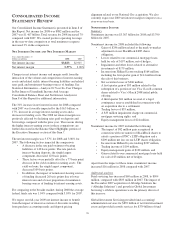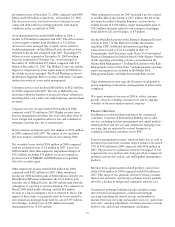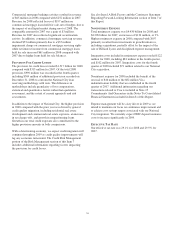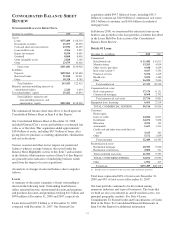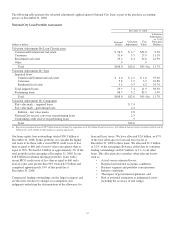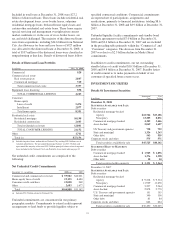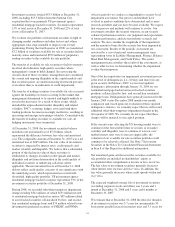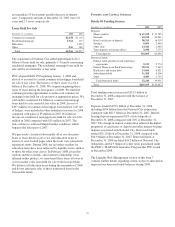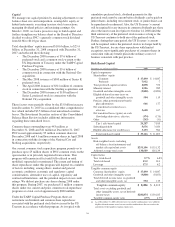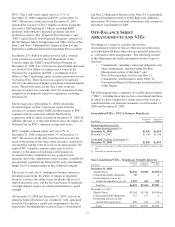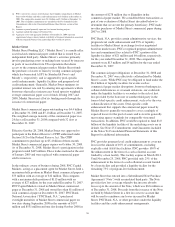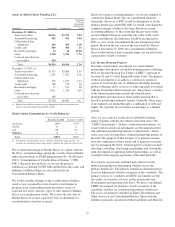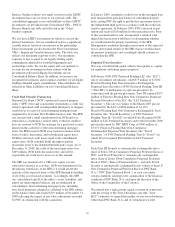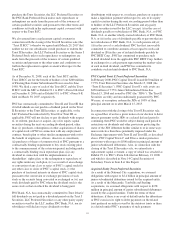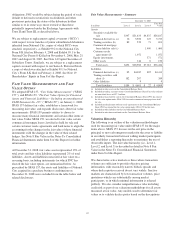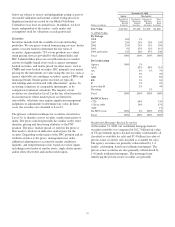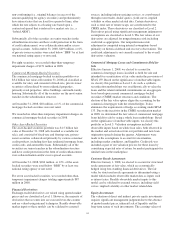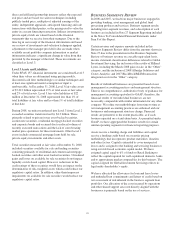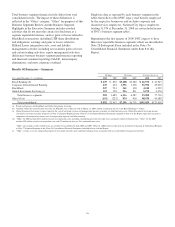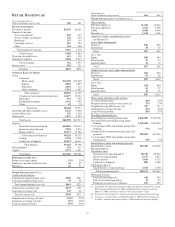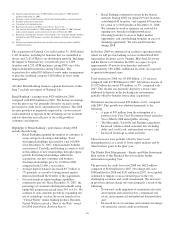PNC Bank 2008 Annual Report Download - page 42
Download and view the complete annual report
Please find page 42 of the 2008 PNC Bank annual report below. You can navigate through the pages in the report by either clicking on the pages listed below, or by using the keyword search tool below to find specific information within the annual report.(a) PNC’s risk of loss consists of off-balance sheet liquidity commitments to Market
Street of $6.4 billion and other credit enhancements of $.6 billion at December 31,
2008. The comparable amounts were $8.8 billion and $.2 billion at December 31,
2007. These liquidity commitments are included in the Net Unfunded Credit
Commitments table in the Consolidated Balance Sheet Review section of this
Report.
(b) Amounts reported primarily represent low income housing projects.
(c) Amounts include the impact of National City.
(d) Aggregate assets and aggregate liabilities at December 31, 2008 represent
approximate balances due to limited availability of financial information associated
with the acquired National City partnerships that we did not sponsor.
Market Street
Market Street Funding LLC (“Market Street”) is a multi-seller
asset-backed commercial paper conduit that is owned by an
independent third party. Market Street’s activities primarily
involve purchasing assets or making loans secured by interests
in pools of receivables from US corporations that desire
access to the commercial paper market. Market Street funds
the purchases of assets or loans by issuing commercial paper
which has been rated A1/P1 by Standard & Poor’s and
Moody’s, respectively, and is supported by pool-specific
credit enhancements, liquidity facilities and program-level
credit enhancement. Generally, Market Street mitigates its
potential interest rate risk by entering into agreements with its
borrowers that reflect interest rates based upon its weighted
average commercial paper cost of funds. During 2007 and
2008, Market Street met all of its funding needs through the
issuance of commercial paper.
Market Street commercial paper outstanding was $4.4 billion
at December 31, 2008 and $5.1 billion at December 31, 2007.
The weighted average maturity of the commercial paper was
24 days at December 31, 2008 compared with 32 days at
December 31, 2007.
Effective October 28, 2008, Market Street was approved to
participate in the Federal Reserve’s CPFF authorized under
Section 13(3) of the Federal Reserve Act. The CPFF
commitment to purchase up to $5.4 billion of three-month
Market Street commercial paper expires on October 30, 2009.
As of December 31, 2008, Market Street’s participation in this
program totaled $445 million. These trades matured at the end
of January 2009 and were replaced with commercial paper
sold to investors.
In the ordinary course of business during 2008, PNC Capital
Markets, acting as a placement agent for Market Street, held a
maximum daily position in Market Street commercial paper of
$75 million with an average of $12 million. This compares
with a maximum daily position of $113 million with an
average of $27 million for the year ended December 31, 2007.
PNC Capital Markets owned no Market Street commercial
paper at December 31, 2008 and owned less than $1 million of
such commercial paper at December 31, 2007. PNC Bank,
National Association (“PNC Bank, N.A.”) purchased
overnight maturities of Market Street commercial paper on
two days during September 2008 in the amounts of $197
million and $531 million and one day during October 2008 in
the amount of $278 million due to illiquidity in the
commercial paper market. We considered these transactions as
part of our evaluation of Market Street described below to
determine that we are not the primary beneficiary. PNC made
no other purchases of Market Street commercial paper during
2007 or 2008.
PNC Bank, N.A. provides certain administrative services, the
program-level credit enhancement and 99% of liquidity
facilities to Market Street in exchange for fees negotiated
based on market rates. PNC recognized program administrator
fees and commitment fees related to PNC’s portion of the
liquidity facilities of $21 million and $4 million, respectively,
for the year ended December 31, 2008. The comparable
amounts were $13 million and $4 million for the year ended
December 31, 2007.
The commercial paper obligations at December 31, 2008 and
December 31, 2007 were effectively collateralized by Market
Street’s assets. While PNC may be obligated to fund under the
$6.4 billion of liquidity facilities for events such as
commercial paper market disruptions, borrower bankruptcies,
collateral deficiencies or covenant violations, our credit risk
under the liquidity facilities is secondary to the risk of first
loss provided by the borrower or another third party in the
form of deal-specific credit enhancement, such as by the over
collateralization of the assets. Deal-specific credit
enhancement that supports the commercial paper issued by
Market Street is generally structured to cover a multiple of
expected losses for the pool of assets and is sized to generally
meet rating agency standards for comparably structured
transactions. In addition, PNC would be required to fund $1.0
billion of the liquidity facilities if the underlying assets are in
default. See Note 25 Commitments And Guarantees included
in the Notes To Consolidated Financial Statements of this
Report for additional information.
PNC provides program-level credit enhancement to cover net
losses in the amount of 10% of commitments, excluding
explicitly rated AAA/Aaa facilities. PNC provides 100% of
the enhancement in the form of a cash collateral account
funded by a loan facility. This facility expires in March 2013.
Until November 25, 2008, PNC provided only 25% of the
enhancement in the form of a cash collateral account funded
by a loan facility and provided a liquidity facility for the
remaining 75% of program-level enhancement.
Market Street has entered into a Subordinated Note Purchase
Agreement (“Note”) with an unrelated third party. The Note
provides first loss coverage whereby the investor absorbs
losses up to the amount of the Note, which was $6.6 million as
of December 31, 2008. Proceeds from the issuance of the Note
are held by Market Street in a first loss reserve account that
will be used to reimburse any losses incurred by Market
Street, PNC Bank, N.A. or other providers under the liquidity
facilities and the credit enhancement arrangements.
38


